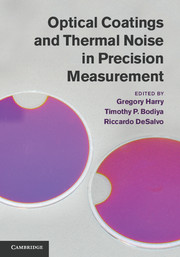Book contents
- Frontmatter
- Contents
- List of contributors
- Foreword
- Preface
- 1 Theory of thermal noise in optical mirrors
- 2 Coating technology
- 3 Compendium of thermal noises in optical mirrors
- 4 Coating thermal noise
- 5 Direct measurements of coating thermal noise
- 6 Methods of improving thermal noise
- 7 Substrate thermal noise
- 8 Cryogenics
- 9 Thermo-optic noise
- 10 Absorption and thermal issues
- 11 Optical scatter
- 12 Reflectivity and thickness optimization
- 13 Beam shaping
- 14 Gravitational wave detection
- 15 High-precision laser stabilization via optical cavities
- 16 Quantum optomechanics
- 17 Cavity quantum electrodynamics
- References
5 - Direct measurements of coating thermal noise
Published online by Cambridge University Press: 05 January 2012
- Frontmatter
- Contents
- List of contributors
- Foreword
- Preface
- 1 Theory of thermal noise in optical mirrors
- 2 Coating technology
- 3 Compendium of thermal noises in optical mirrors
- 4 Coating thermal noise
- 5 Direct measurements of coating thermal noise
- 6 Methods of improving thermal noise
- 7 Substrate thermal noise
- 8 Cryogenics
- 9 Thermo-optic noise
- 10 Absorption and thermal issues
- 11 Optical scatter
- 12 Reflectivity and thickness optimization
- 13 Beam shaping
- 14 Gravitational wave detection
- 15 High-precision laser stabilization via optical cavities
- 16 Quantum optomechanics
- 17 Cavity quantum electrodynamics
- References
Summary
Introduction
Mirror thermal noise has been directly measured in optical cavities with high displacement sensitivity. Direct comparisons between theory and measurement were done in dedicated setups which directly measure mirror thermal noise. In addition, frequency stabilities achieved by fixed-spacer cavities are limited by mirror thermal noise, ultimately by coating thermal noise. In this chapter, we will give an overview of such verification experiments and the experimental techniques which are used.
General considerations
There are two ways to form Fabry–Perot cavities to measure mirror thermal noise (see Figure 5.1).
Free-mirror configuration. Two mirrors are mechanically isolated from each other, like in a gravitational-wave interferometer (see Chapter 14). This configuration more easily allows isolation of the mirror thermal noise from other thermal noises, but is more challenging for suppression of seismic noise. As a result, its measurement frequency range is limited to ≿10 Hz. The displacement measurement is obtained from a control (error) signal which keeps the free-mirror cavity on resonance (Black et al., 2004a). Two identical test cavities allow for common-mode noise rejection. This has typically been done electronically. An optical recombination is also possible, as a Fabry–Perot Michelson interferometer, for the common-mode noise rejection. However, it adds another degree of freedom to be controlled.
[…]
- Type
- Chapter
- Information
- Publisher: Cambridge University PressPrint publication year: 2012



